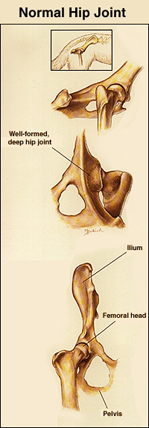HIP DYSPLASIA


The words hip dysplasia means "badly formed hip”. Canine Hip Dysplasia (CHD) is a rather complex disorder and is one of the most widespread problems in the canine world. Symptoms vary widely from one dog to the next. Some dogs have a high pain threshold and may show no signs whatsoever, even though his/hers x-ray tell a very different story.Outward signs of hip dysplasia can range from none, to severe pain. Gait (movement) may or may not be affected.
Some outward signs that may be seen in affected dogs are:
• Difficulty getting up from a lying or sitting position or in climbing stairs.
• A bunny hop gait (moving both rear legs together.)
• A painful reaction to extension of the rear legs.
• Pushing on the rump may cause the pelvis to drop.
• When rolled over, some affected dogs will resist having their legs spread into a frog-leg position.
• A side to side sway of the croup
• Dogs may resist jumping
• Lameness may be seen especially after strenuous exercise.ng a dog's hip status
In unaffected dogs there is a good fit between ball and socket. An easy way to think about it is to imagine a tennis ball and a cup. If you put the ball into the cup there is a good fit. If you put the ball into a saucer, it will roll around loosely. This poor fit is characteristic of dysplastic dogs.
Remember - the ONLY way to tell if a dog is Dysplastic is to x-ray his/her hips.
It is virtually impossible to tell if a dog is Dysplastic merely by looking at it. You must take an x-ray and then have those x-rays evaluated by experts. Since this is an inherited disorder. It is vital that dogs be tested and cleared before being bred. Otherwise the condition will only become more and more prevalent.
The British Veterinary Association (BVA) and The Kennel Club in the UK (TKC) have joined together to run a hip scoring scheme for breeders in order to combat and test for canine Hip Dysplasia. At the moment this is the most reliable method we have of checking the status of hips.
From the x-ray taken at the owner's vets, the BVA scores each of the hip joints — the norberg angle (0-6); subluxation (0-6); cranial acetabular edge (0-6); dorsal acetabular edge (0-6); cranial effective acetabular rim (0-6); acetabular fossa (0-6); caudal acetabular edge (0-5); femoral head and neck exostosis (0-6); femoral head recontouring (0-6), thus each hip can receive a maximum score of 53 and overall score of 106. The lower the score the better, so 0/0 would be perfect, while 53/53 would mean that the dog had no hips at all.
|
POINTS OF THE HIP JOINT ANATOMY
1. Cranial Acetabulem Edge 2. Cranial Effective Acetabulem Rim 3. Dorsal Acetabular Edge 4. Caudal Acetabulem Edge 5. Joint Space 6. Head of Femur (ball) 7. Neck of Femur 8. Acetabulem Fossa 9. Lesser Trochanter |
 |
The BVA/TKC publish a list of Breed Mean Scores (BMS) for each breed, together with the number of dogs tested to date and the range of scores achieved. It is then recommended that breeders ensure their breeding stock have scores which are below the BMS. The Breed mean score for German Shepherds is 19.
The welfare of our breed lies in the hands of the buyers at least as much as it is in the hands of the breeders. We are not talking about a minor defect here, such as a curly tail or mismarked colour. Hip Dysplasia is a crippling disease, which brings considerable pain and suffering to both the dog and its owner. If we truly love our dogs, we’ll each do our part to help lower the rate of C.H.D.
Nutrition may play a role in the development and severity of Canine Hip Dysplasia. Overfeeding associated with very rapid weight gain during the first 2 months of life has been associated with a higher incidence of hip Dvsplasia. It is important to maintain puppies at a proper weight, rather than to allow them to become too heavy early in development. Diets should provide the high level of protein necessary for proper development, but should not be present at such high levels that the puppies become podgy.
We cannot cause Hip Dysplasia by what we feed UNLESS the dog carries the genes for Hip Dysplasia. Keeping puppies lean as they are growing will NOT eliminate Hip Dysplasia in every dog, but MAY make it less severe or, in some cases, prevent it from showing up in some individual dogs.
Some common factors. which have been proposed to worsen, but not cause, CHD are:
• Rough play, jumping, climbing stairs or slick floors.
• Excess weight gain or rapid growth.
• Calcium supplementation (may increase the bone remodeling).
• Forced running for any distance, especially on tarmac, asphalt or other hard surfaces.
So please be aware of what/how much you feed your puppy, and monitor all exercise carefully. I compare this to a small child/toddler. You would not take your toddler for a 3 mile hike. It is the same for your new puppy.
No up and down the stairs or furniture. It may look like fun, but it puts far too much strain on young growing bones. When puppy is in the car please lift him/her out instead of allowing him/her to jump.
THE BVA/KC HIP DYSPLASIA SCHEME
www.bva.co.uk/public/chs/hip_scheme.asp
www.the-kennel-club.org.uk/health_issues/health_issues_content.asp?ID=103